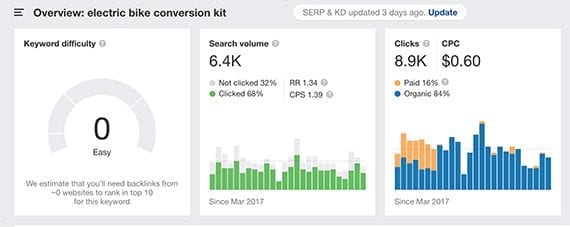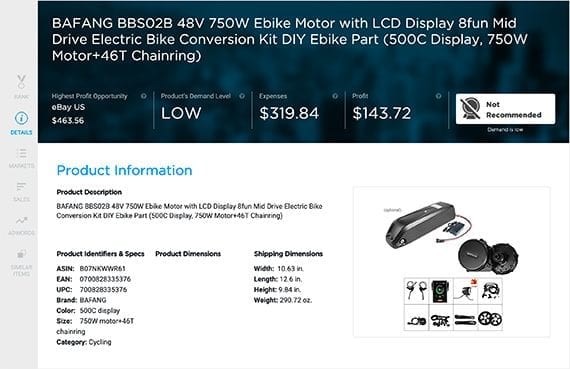
Identifying a profitable ecommerce niche can be tricky. There are tools that can help. Algopix, for example, analyzes marketplaces worldwide to estimate product demand.
Amazon sells everything, seemingly, as does Walmart. And they do it well. But most ecommerce businesses are not Amazon or Walmart. For those businesses, attempting to sell everything to everyone can lead to failure.
Competing with the Amazon’s and Walmart’s of the retail world requires a significant investment. Perhaps hundreds of millions of dollars.
Here is an example. Ecommerce entrepreneurs Marc Lore, Mike Hanrahan, and Nate Faust launched Jet.com in July 2015 after about 350,000 folks had used the site during a beta period. At the launch, Jet had a reported 4.5 million products. Clearly, it was built to sell everything to everyone.
In short order, the company raised $820 million from investors. And in August 2016, Walmart acquired Jet.com for $3.3 billion. You could call it a success.
If your ecommerce business can raise $820 million, by all means give this approach a try. If not, consider a smaller niche with fewer competitors and a better chance at success.
The Importance of a Niche
Lore, one of the Jet.com founders, started with a niche. Back in 2005, Lore and Vinit Bharara launched 1-800-diapers. The site became Diapers.com.
In its first year, the company sold an estimated $2.5 million in baby products. A few years later, Diapers.com and sister sites Soap.com and Wag.com sold for more than $500 million. So it is still possible to make a lot of money in a niche product market.
An ecommerce niche has at least three advantages for most businesses.
Less competition. When your business serves a product niche it should face relatively less direct competition. This is true even if Amazon or Walmart sells a particular item.
Take an example from brick-and-mortar retail. Walmart sells bicycles, but there are still many successful specialty bike shops. There are several reasons for this. Walmart tends to focus on inexpensive bikes, while specialty shops offer much higher quality inventory. Walmart associates are not bike experts and in most cases won’t help to repair a bike, but a local specialty shop will.
More voice. If your business uses content marketing, it is easier to position your company as a market leader and expert in your niche.
Think again about a local bike shop versus a massive department store. A local shop should have more product knowledge and can otherwise position itself as bicycling experts.
Search engine optimization. New ecommerce businesses often live or die on SEO. General keyword phrases can be more difficult to rank for than long-tail, niche phrases. Thus, it could be easier to generate site traffic for niche products.
Next, let’s consider four steps to choose a product niche.
4 Steps to Discover a Niche
1. Research the product. There is a significant difference between developing a product that doesn’t exist and aggregating available products into a niche.
In the former case, to create a product you would ask questions about customer problems, wants, and needs. But when your aim is to assemble products for a niche, you would typically focus on convenience and service.
Here is an example. There are a couple of million vegans living in the United States. Some of these vegans have chosen the diet for its health benefits. They wanted to be leaner. Or they had suffered from joint pain.
The second group of vegans chose the lifestyle because of the animals. These vegans believe that consuming meat is animal cruelty. The group not only refuses to eat a hamburger, but also won’t wear leather, silk, or any clothing or shoes made from animal products. This is a product niche opportunity.
Most men’s dress shoes are made of animal skin leather. If a vegan wants to buy a dress shoe, he has to research several shoemakers to identify the one or two styles that each produces from plant-based materials.
An online retailer could make this much more convenient. This retailer could identify all of the vegan styles available from 50 different shoe manufacturers and aggregate them into a single store.
You could identify similar product niches by asking service and convenience questions.
Try this. Write a list of some of your hobbies and interests. How do those hobbies or interests impact your shopping behavior? What could be done to make shopping for those items easier, faster, or more convenient?
You could ask business partners and friends to complete this same exercise. The goal is to have a list of fairly narrow product niches. Use the list to continue your research.
- Men’s vegan dress shoes.
- Rooftop gardening supplies.
- Loose leaf tea and accessories.
- Electric bike conversion kits.
- Dog training gear.
- Women’s hunting apparel.
2. SEO. For each item on your list, research keywords for SEO. One of the reasons to seek an ecommerce niche is the potential to rank for important, product-related keywords.
SEO research will also help you decide if your niche is too small or too large. It can give you an idea of how much traffic you may be able to generate for your ecommerce business, and it can help you determine how much competition you could face.
Consider the example of rooftop gardening supplies. You could use an SEO tool such as Ahrefs to vet this niche.
It turns out that the exact phrase “rooftop gardening supplies” gets very few searches in a given month. So you could modify the term, trying “rooftop gardening” and then “rooftop garden.”

Ahrefs reports relatively low search traffic for the phrase “rooftop garden.” The term also has a keyword difficulty score of 15.
For “rooftop garden,” Ahrefs reports an average of 4,400 monthly searches and a keyword difficulty score of 15. This means the term could be a bit of work to rank for, and might not have enough monthly search traffic to justify an entire niche.
Let’s try another ecommerce niche idea, “electric bike conversion kit.” For this term, Ahrefs estimates that the term gets 6,400 monthly searches on average and it would be easy to rank for it.

“Electric bike conversion kit” has a bit more traffic (although it is still a relatively small number) and a very low keyword difficulty score.
The related phrase, “electric bike kit” gets about 12,000 monthly searches and has a keyword difficulty score of 3. Electric bike kits might be a niche with potential.
There are other SEO research tools besides Ahrefs. Use your favorite method. The aim is to decide if you believe there is enough search traffic to help make your ecommerce niche profitable, and determine if your site could rank for important keyword phrases.
3. Supplier research. Once you have identified a few possible product niches, it is time to start looking for potential suppliers. The aim in this step is to get a list of the specific products your ecommerce business could sell.
This will require some work. As an example, if you want to have a loose-leaf tea business, you could search Google for “tea wholesaler” or “tea importer” to develop a list of a couple of dozen companies. You would then contact each, obtain prices, and learn about their payment terms and minimum order requirements.
Some industries have supplier directories. There are supply chain services, too. Worldwide Brands, for example, publishes a directory that includes suppliers for many product categories.
Again, get a catalog or list of available products from each supplier you are considering.
4. Product analysis. You can now analyze the available products from the various suppliers.
For example, Algopix can identify product opportunities for marketplace sellers. But it can also be a good indicator of product demand and profitability.
Perhaps you are still researching the electric bike kit niche. You have a supplier willing to provide a BAFANG BBS02B 48V 750W electric bike motor with an LCD display for $250. If you search Algopix for this, you can gain some interesting insights.

Algopix offers insights about how a product might sell in marketplaces. This, in turn, may help you decide if there is good potential for your niche.
For example, Algopix does not recommend the product for marketplaces. Shipping costs, payment processing fees, and marketplace fees add up to about $69. And you would perhaps need another $44 in pay-per-click ads to get a sale, further adding to the cost.
Algopix also projects a relatively low demand. It estimated that you might sell 20 in a month on Amazon and eBay. But 20 per month could generate $2,800 in profit. If your niche ecommerce business had 50 similar products, you could grow to perhaps $140,000 per month in profit.
Here you don’t need to take the recommendation of a tool. Rather, decide if you’re comfortable with the products you are considering.